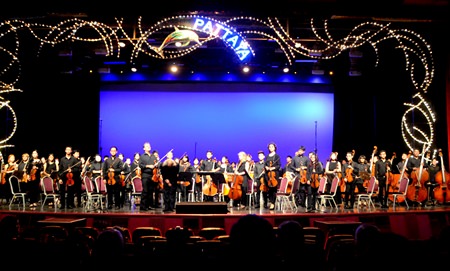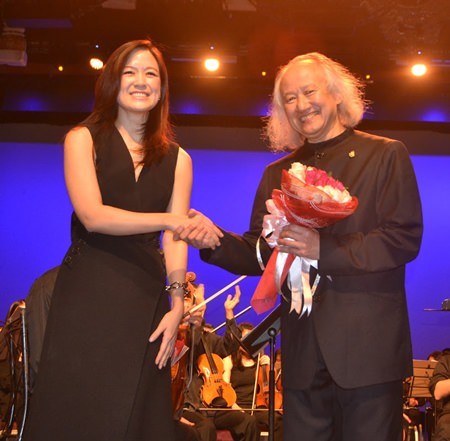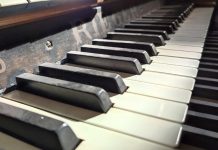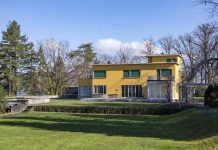For the last few years, Tiffany’s Show Theatre has been the slightly unlikely venue for the Silpakorn Summer Music School Orchestra’s annual Pattaya concert. But in many ways it’s a perfect setting. There’s a large parking area, an attractive entrance hall, a spacious lobby on the next floor and a massive auditorium with comfortable cinema-type seats. To my mind the acoustics are excellent, a bit on the dry side perhaps but this makes it possible to hear the detail in the orchestral texture.
I chose a seat in the balcony, because although they’re cheaper than those in the stalls, they offer a better view and clearer sound. Few people realise this, so please keep it to yourself. The enormous orchestra of a hundred young musicians covered the massive stage area but something looked slightly odd, though at first I couldn’t work out what it was. Then it suddenly dawned on me: the viola section had been placed to the right of the stage near the front, a position normally taken by the cellos. This is an unusual seating arrangement but it worked, because it improved the balance of the string sound.
 The Silpakorn Summer Music School Orchestra takes a standing ovation at the conclusion of the April 9 concert.
The Silpakorn Summer Music School Orchestra takes a standing ovation at the conclusion of the April 9 concert.
Silpakorn Summer Music School is held annually and regularly directed by the distinguished Japanese conductor Hikotaro Yazaki. The course is made possible with generous support from Siam Commercial Bank and the Siam Commercial Foundation. The actual concert was a joint venture between Silpakorn Summer Music School, Pattaya International Ladies’ Club and Pattaya Classical Music with part of the profits donated to Kate’s Project Trust, a charity that works to improve the living conditions of disadvantaged families.
The SSMS Orchestra, led by distinguished violinist Leo Phillips seemed on sparkling form and compared to previous years it sounded more assured and more competent. The string and brass sections seemed especially confident and there was some compelling playing from the woodwind.
The concert opened with the rarely-heard Suite No. 7 for Orchestra by Jules Massenet entitled Scènes Alsaciennes. He was an amazingly prolific composer with thirty operas and dozens of other works to his credit. Written in 1882, this work is the last of his orchestral suites, four musical pictures of different places and times of day in an Alsatian village.
 Alisa Phanthusak (left), Assistant MD of Tiffany’s Show Pattaya, presents a bouquet of flowers to Japanese conductor Hikotaro Yazaki.
Alisa Phanthusak (left), Assistant MD of Tiffany’s Show Pattaya, presents a bouquet of flowers to Japanese conductor Hikotaro Yazaki.
It began with an impression of a quiet Sunday morning (Dimanche matin) and the lyrical, melancholy music brought out some fine string playing. The tavern scene (Au cabaret) was marked by some excellent brass ensemble playing while the third movement (Sous les tilleuls) depicted a summer afternoon under the linden trees. It had a mysterious opening, sensitively played by violas and cellos and the haunting cello and clarinet solos created a sense of timelessness. I couldn’t help noticing that for once, the rather intrusive drone of the air-conditioning system matched the key of the music.
The theatrical finale described a lively Sunday evening (Dimanche soir) and the military sounds of beating the retreat, a reminder that Alsace was lost to Germany after the Franco-Prussian War. The brass section excelled in this movement and the off-stage solo trumpet sounding the retreat was played impeccably.
Tchaikovsky’s 1812 Overture was written in 1880 to commemorate Russia’s defense against Napoleon’s disastrous invasion of 1812. The overture is best known for its percussion effects, cannon fire and chiming bells. The dry acoustic of Tiffany’s was ideal to appreciate the complex textures in this work in which La Marseillaise is interspersed with Russian folk melodies and the Russian national anthem.
I discovered this piece as a teenager and played the LP endlessly, but the SSMS orchestra gave the most satisfying performance of the work I’ve heard. The finely-judged string balance was especially noticeable in the opening section in which a small group of cellos and violas sensitively played the solemn opening theme. The busy contrapuntal sections were a showpiece for the strings and the lyrical second main theme was beautifully phrased. For the heroic closing section, several brass players had moved to the front of the balcony to create a wonderful feeling of surround-sound, helped by thunderous percussion from the orchestra. The original score calls for real cannons but perhaps these would have contravened fire regulations. A pair of elephantine bass drums was employed instead, with a breath-taking effect. It was a thrilling occasion.
The concert concluded with a splendid performance of Brahms Symphony No. 2, a lyrical work that dates from the summer of 1887. The woodwind and low strings sounded better than ever in the gentle pastoral opening, the mood of which always reminds me of Beethoven’s Pastoral Symphony.
The majestic second movement opens with an expressively played melody from the cellos while the waltz-like opening of the third movement began with some elegant woodwind playing especially from the oboes. In this movement the mood alternates between the waltz-like theme and a more lively spiky melody and the whole was performed with a superb lightness of touch.
Conductor Hikotaro Yazaki brought a fine sense of pace to the finale with many effective dynamic contrasts. There were some excellent woodwind solos too. In this symphony, there are several difficult moments to navigate and some demanding string writing, but Mr Yazaki steered the orchestra through the challenging work with a firm and experienced hand and brought the symphony – and the concert – to a triumphant and satisfying conclusion.




